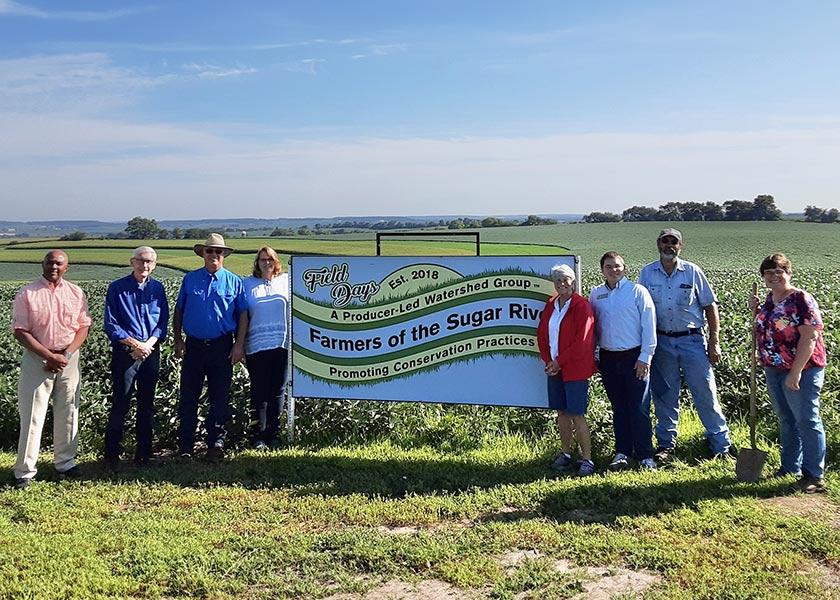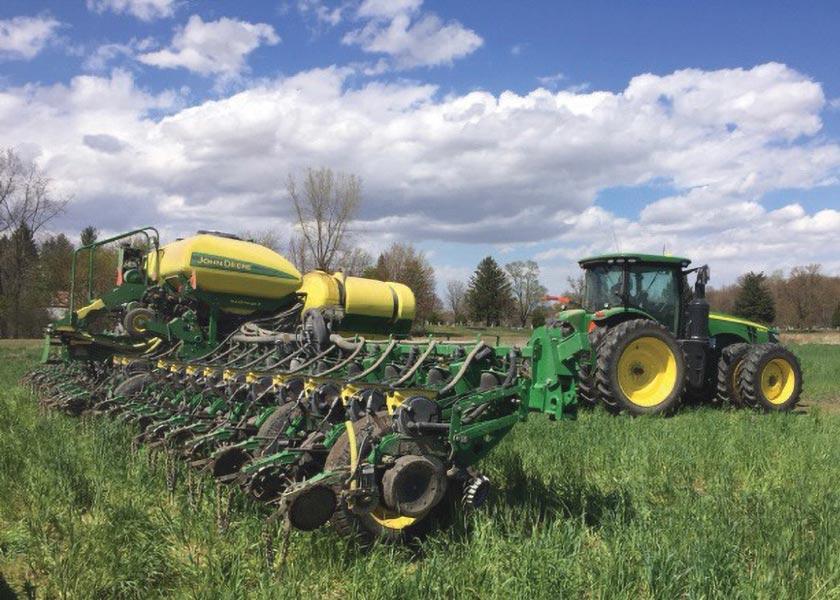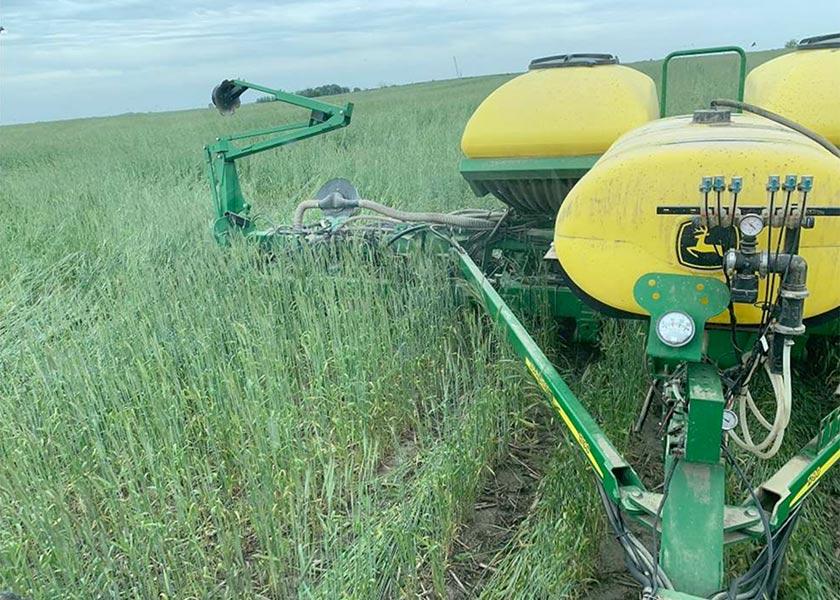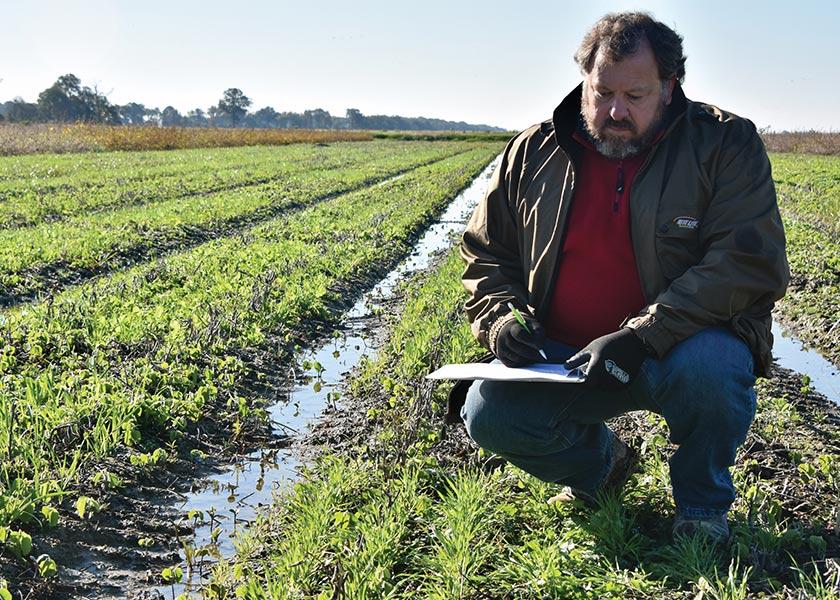.png)
Taking a “deep-dive” into the farm operations of the four U.S. regional winners of the 2024 Conservation Legacy Award program, it was interesting to see the strong emphasis placed on no-till and cover crops.
Both practices served as highlights for this year’s four winners:
- Brad and Joyce Doyle, Weiner, Ark.
- Jacob Kaderly, Monticello, Wis.
- Donald Morse, Birch Run, Mich.
- Chris Von Holten, Walnut, Ill.
The Conservation Legacy Award recognizes outstanding on-farm environmental plans, income and profit results, along with contributions to the conservation community. The program is sponsored by the American Soybean Association, BASF, Bayer, Nutrien, the United Soybean Board/Soy Checkoff and Valent USA. Videos of each of these cropping operations are available at AgWeb.com.
Here are a few no-till and cover crop insights found in an in-depth look at what these farmers are doing with no-till and cover crops.
No-Tillage Offers Huge Benefits
No-Till Overcomes Health Concerns
Jacob Kaderly credits his father’s service on the Wisconsin State Conservation Board during the 1970s with fostering his passion for land stewardship. No-till was a way for him to get started in farming without spending a lot of money on equipment. Plus, he was already familiar with no-till, having watched his father use the practice in the 1980s.
“No-till made my investment minimal and enabled me to start farming,” says Kaderly. “With the expense of buying big equipment to do tillage, you can save so much more money going no-till. Every trip across the field costs you. It’s not good for the soil, and it’s expensive.”
A huge dust reduction with no-till and newer tractor cabs keep Kaderly from breathing in damaging dust that had previously been impacting his health.
No-tilling 4-8% slopes let him navigate the farm’s rolling terrain where he grows corn, soybeans and wheat.
“We farm on the contour,” he says. “Breaking up fields in those strips really helps with soil loss because we have different rotations on the hillsides to keep the soil in place. By keeping the soil in place, I’m retaining all the nutrients and fertility, while increasing the farm’s production ability. No-till and cover crops have also dramatically increased water infiltration in the soil.”

No-till and cover crops help Jacob Kaderly of Monticello, Wis., demonstrate the benefits of increased water infiltration to educators and politicians. Photo by: Farm Journal
Kaderly conducts soil tests on 2-acre grids with a double purpose. He uses variable rate technology one year to apply phosphorus (P), potassium (K) and lime, while the second year he concentrates on maintaining nutrients in the soil.
A regular attendee at No-Till Farmer’s National No-Tillage Conference Kaderly received the Responsible Nutrient Practitioner Award at the 2018 event. A firm believer in the benefits of no-till and cover crops, the Certified Crop Advisor touts what good stewardship can do to optimize soil fertility and farm profitability, while working closely with farmers on about 10,000 acres.
Scouting fields every 10 days along with no-tilling Bt corn in a 3-year rotation keeps insect pressure at bay. Alternating crops and chemical programs help manage weed resistance.
“I try to use different modes of action every couple of years in my chemical applications,” Kaderly says. “I also have mowed my cover crop after wheat to control water hemp seed production.”
Conservation in Family Conversations
Donald Morse’s courtship with no-till goes back almost 50 years. Back in 1975, he put no-till to the test on the family’s Michigan farm, long before the federal government began offering soil-saving subsidies.
Raised in a farm family where conservation was frequently the dinner-time conversation, Morse no-tills soybeans, corn, sugar beets and wheat in the family’s 3,100-acre operation. He credits no-till with making fewer trips across a field while reducing compaction, improving soil health, saving huge amounts of fuel and trimming labor needs.
“It all goes into making the land better when you’re done with it than when you found it,” he says. “Cover crops and no-till all contribute to making the soil better now than when I found it.
“If you can raise your organic matter in the soil, you’re increasing water-holding capacity and increasing the amount of organic nitrogen (N) that gets released, which means you don’t have to buy as much fertilizer.”

No-till and cover crops contribute to a farm family legacy for Donald Morse Mich., in Birch Run, Mich., that started with no-till in 1975.
Looking at long-term sustainability, Morse knows organic matter is exposed to soil oxygen every time steel enters the ground with tillage and every pass burns organic matter.
“That’s not really sustainable over the long term,” Morse says. “By doing no-till, we’re helping ourselves be sustainable over the long term, and that makes us financially more viable.”
Tackling Heavy Tillage Traditions
Farming where heavy tillage is still highly popular, Brad Doyle found this was among the family’s greatest challenges in moving to no-till. While conventional tillage is still commonplace in his area of Arkansas and delivers high yields, Doyle recognizes how much soil is lost with this method of seedbed preparation. Plus, he’s seen how traditional tillage can be taxing on farm labor and fuel use.
“Every pass you make across that field doesn’t necessarily have to happen if you go to a no-till system,” Doyle says, who grows soybeans, rice and wheat in the Mississippi River Delta area of Arkansas. “Timeliness for planting is critical for us to get higher-yield potential. No-tilling opens the door for us to possibly have an earlier planting date and reduce our labor costs.”
Two on-farm reservoirs provide irrigation water for 100% of the acreage, along with offering valuable waterfowl habitat.
Drought Led to More No-Till
After graduating from college in 1994, Chris Von Holten returned home to farm with his father and start his own crop operation. Using a moldboard plow, he worked the ground on a 160-acre rented farm before switching to chisel plowing. Seeing how a local farmer had benefitted from no-till, the father-son duo each no-tilled corn in the spring of 1987 simply by adding row cleaners to an existing planter.
No-tilling on the contour with terraces built in the 1950s catches and slows water from washing down those hills. With 10% slopes in contoured fields, rows planted up and down the slopes often wash away, even with no-till and cover crops.
“Then 1988 brought a drought that showed us the benefits of no-till and water conservation,” Von Holten says. “Our no-tilled corn fields yielded significantly better than our conventionally planted corn that year.”
That drought was all the inspiration needed to begin no-tilling soybeans. While their early years of no-till saw successful yields, much was also learned from their mistakes, such as how to make improvements to the corn planter, no-till drill and weed control.
“With our variable soil types and slopes, we need to control erosion and retain water in our soil profile,” he says. This has led to favorable results with no-tilled corn, soybeans and wheat through improved soil health and a positive impact on the bottom line. Retaining fertility and moisture has increased yields, helped his better soils get better and add more air to his poorer soils.
Cover Crops Offer Year-Around Food for Microbes
Seed Into Standing No-Tilled Corn, Soybeans
Seeding cover crops helps Morse improve soil organic matter and increase water-holding capacity on his mid-Michigan farm. Rye is aerially seeded into no-tilled corn and broadcast into no-tilled soybeans in early to mid-September.
“As far north as we are, I’ve found the best way to get the rye established is to get it out there before soybean leaf drop, and that gives it time to get going,” he says.
Although he’s seeded oats, wheat and clover as covers, rye is his go-to cover crop.
“Rye is just a really hardy species,” he says. “It puts down roots that will make biomass.
“Cover crop roots provide year-round food for microbes. I like to see a high population of soil microbes because they chew up the plant residue, corn stalks and wheat straw. The higher the level of microbes, the faster you’ll decompose the residue and get nutrients back in a usable form that’s available to the plant.”
Keeping a rye cover crop growing throughout the winter builds the soil microbiology. Along with no-till, cover crops add organic matter and improve soil health, while soil erosion and surface runoff are less likely with an overwintering cover. Cover crops also allow the soil to sequester carbon and actively grow into the spring, which creates a competitive environment for controlling noxious weeds like resistant Palmer amaranth, marestail and pigweed.
“If you raise organic matter, you increase water-holding capacity and the amount of organic nitrogen that gets released,” Morse says.
In the spring, soybeans are no-tilled into actively-growing rye. Terminated prior to no-tilling corn, the rye doesn’t tie up excess N. Morse bands low salt phosphorus and potassium liquid fertilizers with the planter to promote soil health.
Rye Cover Works with Twin-Row Wheat
In 2015, Von Holten no-tilled cereal rye into no-tilled corn fields that he planned to rotate to no-till soybeans. Encouraged by the results, he started seeding rye on no-till soybean ground going to no-tilled corn.
“From those positive results, I started planting rye in the fall of 2018 on bean stubble for fields going to corn to help control erosion,” Von Holten says. He has used a strip-till bar in both the fall or spring to apply fertilizer. Despite having rye growing close to these strips, the strips would often wash away in a heavy rain. It soon became apparent that he needed to stop strip-tilling and rely on the rye roots for tillage.

Planting green into a rye cover crop helps Chris Von Holten improve both yields and water infiltration on his Walnut, Ill., operation.
Residue from the rye keeps weed pressure to a minimum, resulting in lower rates of post-chemical applications. He seeds 50-80% of his fields to cereal rye to keep a living root in the soil as long as possible to improve soil structure and increase the soil’s underground biology.
Improved water infiltration has been among the biggest cover crop benefits. The soil holds up better to equipment compaction and he can no-till when soil conditions are damp.
Seeding 7 ½-inch twin-row wheat allows for earlier planting of double-crop soybeans, while leaving 22 ½ inches for tractor and planter tires. Similar to a cover crop, wheat keeps a living root in the soil through the fall and early spring when fields are most vulnerable to erosion. The side benefit is the extra income earned from the wheat and earlier planting of double-crop soybeans.
With 8-10 soil types in some fields, he says cover crops have helped raise yields on the poorer soils. Variable fertility rates and seeding capabilities aid in managing wide variations in productivity.
Wheat Replaces Rye as Cover Crop
Kaderly finds seeding wheat as a cover is easier to manage than rye. He previously seeded a 7-way cover crop mix that included peas, oats, red clover, sorghum-sudangrass, alfalfa, radish and hairy vetch.
“That mix generated 80-100 pounds of N for the next corn crop,” Kaderly says. About 5 years ago, we started seeding rye after beans and corn to help in the spring with erosion. Since then, we’ve transitioned to wheat with a goal of keeping the soil covered year-round.
With cover crops, he’s seen better water infiltration, less erosion and better soil health. By soil testing every other year, he’s seeing if cover crops are helping to increase fertility.
Focus on Highly Eroded Slopes
Through research, Doyle identified the cover crops best suited for the area’s heavy, water-logged soils where he grows soybeans, rice and wheat. About 25% of the farm’s 100% irrigated acreage is seeded to covers with airplanes and drills with a focus on winter cover for waterways, field edges and highly erodible sloped fields.
“Many covers will not survive, but we use a combination of cereals ahead of soybeans,” Doyle says. “Before rice, we focus more on non-cereal crops, as grasses can leave root exudates that injure other grasses.”

Weiner, Ark., no-tiller Brad Doyle finds sampling soil in grids has led to huge savings in phosphorus needs.
Radish, buckwheat and cereal rye help hold nutrients near the surface and prevent weed emergence ahead of no-tilling soybeans. More on-farm cover crop research is planned to test new varieties and seeding rates to identify the best choices for different soils. Working with the Arkansas Game and Fish Commission and the National Wild Turkey Federation, cover crops and food plots feed more than 20 wildlife species living on the farm.
Doyle has found no-till soybeans respond very well to applications of poultry manure that increase organic matter and benefit soil health. Frequent soil testing and grid sampling allow Doyle to stay on top of fertility and nutrient availability. Accurate soil testing and GPS variable rate-fertilizer application reduce the risk of P runoff.






